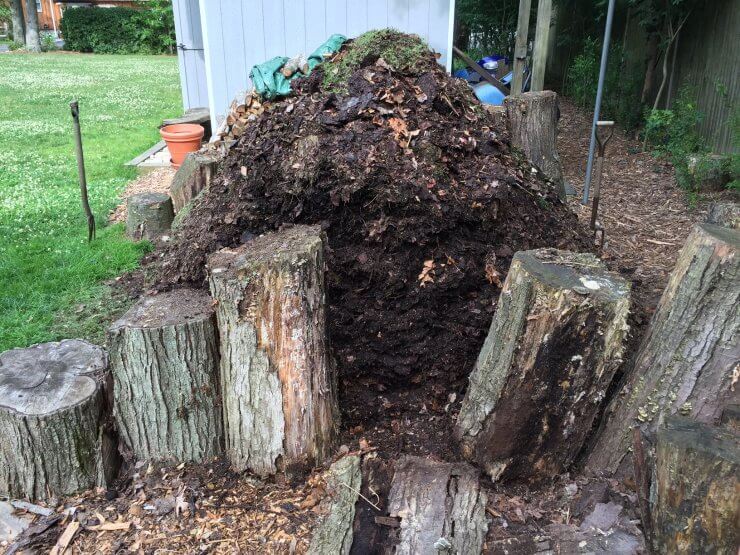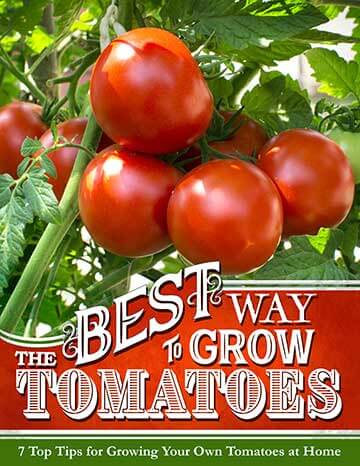
It’s a Friday in late June, a perfect midsummer’s eve for some leisurely yardkeeping. In my world, cocktail hour is garden hour, and unwinding from the workweek by reconnecting with the ground I keep is a pleasure, especially at this time of year when the plants are intoxicated with new growth.
I start by mowing the lawn, collecting three hoppers of grass clippings. As I put the mower back in the shed and empty the last hopper of clippings at the base of my large, open-face compost heap, I consider my pile. Over our last few sessions, I’ve thoroughly worked its front and back sides, strip-mining the flanks to aerate it and mix it full of fresh greens from the kitchen and yard. It’s time to shift my pile from side to side.
Discover 7 top tips for growing, harvesting, and enjoying tomatoes from your home garden—when you access the FREE guide The Best Way to Grow Tomatoes, right now!
Having gouged out the periphery of the bell-shaped heap for crumbly leaf mold, I’ve exposed the four corners of the log walls inside the crib, leaving a reach of only a couple feet or so in the lower middle untouched. I start on the left side, channeling my way along the wall from front to back with the hay pitchfork. The deeper I drill, the richer the compost. My pile feeds off the decay of the log walls that contain it, themselves well on their way to rotting.
I pry thick wads of raw dry leaves from the crevasses, stuck like dreck between teeth, which will be perfect for mixing with today’s grass clippings, creating a foot-wide gap along the length of the heap and portside log wall. The entire left side is revealed in cross section, a thick stack of cold-pressed compost that begs to be further teased and turned out. This Humpty-Dumpty of a pile needs a great fall.
To gain ready access to this newly exposed quadrant of the heap, I teeter to middle log to its side. Standing perpendicular to the wall of newly exposed compost, I step in close with the pitchfork to unbind the pressed leaf mold and seaweed laid down early last fall and turn it loose onto the top and backside, mixing the oldest part of my pile with the newest.
At last I’ve chiseled deep enough into the base so the overhanging matrix tumbles to the ground. I set the two logs back in place and draw some of the newly expunged leaf mold up against them, adding at intervals fresh grass clippings and tossed layers of rotted leaves from the backside. In all, I’ve carved about a third of the way into the left side. My pile is now a slightly lopsided version of its former self, taller and much suffused with air and freshly mixed compostables. It turns out you can put Humpty-Dumpty back together again.
The next morning, the heap is in its cups, positively Falstaffian in its fulsomeness. I’m surprised at how little it has settled, even after an overnight rain. The leaf litter across its rounded surface is moist and crumbly, mottled with moldering grass clippings and clumps of caked-together leaves bound by humus in the making. The whole lot is well on its way to recomposing itself as a matrix of new earth that I can shovel up instead of disassembling with pitchfork.
These days, especially when my pile is damp with rain, it takes only a scrape with a rake or pitchfork to uncover all manner of millipedes, roly-polys, skinny red worms, and fat racers. It’s amazing to see how much life is contained within the heap, even just scratching the surface.
Each morning and evening when I let Miller out the back door, he makes a beeline for the back of the yard and circles around my pile. Sometimes he chases off a squirrel or sniffs out a chipmunk, but more often on these midsummer days, morning or night, he gives flight to two or three robins that have taken to perching atop the heap. I can see telltale signs they flick about the surface, scattering flecks of leaf litter in search of easy pickings.
Not unlike the peckish birds, I inspect the surface of my pile each time I visit, plucking out the twigs and wood chips that continually bob up like corks to the surface. Mostly such grooming is my way to stay connected with my pile, much in the same way I enjoy picking up seashells and curious rocks at the beach or even checking the dog for ticks. A touch is sometimes all it takes to stay connected, as any chimp will tell you.
Today, the roly-polys are out in force, and I linger to follow one traversing the escarpment of crumbled leaves. Roly-polys have fascinated me since I was a kid, in much the same way sightings of horseshoe crabs did on summer vacations to the seashore. Both appear—heck, truly are—prehistoric, having persisted since before the dinosaurs were even a thing. I like how people call them whatever they want: doodle bugs, woodlice, pill bugs; Brits know them as chiggypigs, penny sows, and cheesybugs. I’ve always thought of them as mini armadillos. Whatever name you call them, they were made for composting. Thanks to a special brand of bacteria in their gut, roly-polys are incredibly efficient at chewing up rotting vegetation. Their diet includes self-coprophagy, which means they scarf up their own feces to take in nutrients they may have missed the first time around. Being tolerant of ammonia gas, they don’t urinate, and instead excrete waste fluids through their shells. They’re such tough little guys, they can take in heavy-metal ions and crystallize them in their bodies, which is why researchers are studying how they can be used to help detoxify contaminated industrial sites.
And guess what? Like my earthworm buddies, the roly-poly isn’t native, having rolled up to these parts from the Mediterranean in the eighteenth century to find its niche in the New World ecosystem. My favorite factoid about the doodle bug? They have gills and are actually crustaceans. (And horseshoe crabs are not crustaceans; they are in the spider family. Darwin’s evolutionary tree has some really twisted branches.)
The hard-pounding rain has exposed, as it always does, a fresh smattering of wood chips and twigs to flick away. Flotsam and jetsam from the beach constantly reveal themselves as well—I collect the rubber heel of a flip-flop, a stretchy wristband, and other scraps of plastic to take back inside to the garbage can in the kitchen. Today’s surprise find is a salad fork, likely discarded from a dinner plate hastily scraped off by one of the neighbor girls and dumped into the food-waste bucket I take off their hands each week. Its tines are crusted with humus; I’ll stick it in the dishwasher before returning it, once again shiny and stainless. My pile is nearly done. I can tell not by sticking a fork in it, but by pulling one out.
Scott Russell Smith is the author of “On Compost: A Year in the Life of a Suburban Garden” (Christmas Lake Press, 2024), from which this excerpt was adapted.
Note: Food Gardening Network contains links to affiliate websites, including Amazon and Rakuten Affiliate Network, and we may receive a commission for any eligible purchases made by you through links on this page. Any reviews are based on honest reviews of the products.
Discover 7 top tips for growing, harvesting, and enjoying tomatoes from your home garden—when you access the FREE guide The Best Way to Grow Tomatoes, right now!




